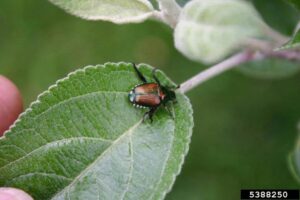June Insects in the Garden
go.ncsu.edu/readext?868634
en Español / em Português
El inglés es el idioma de control de esta página. En la medida en que haya algún conflicto entre la traducción al inglés y la traducción, el inglés prevalece.
Al hacer clic en el enlace de traducción se activa un servicio de traducción gratuito para convertir la página al español. Al igual que con cualquier traducción por Internet, la conversión no es sensible al contexto y puede que no traduzca el texto en su significado original. NC State Extension no garantiza la exactitud del texto traducido. Por favor, tenga en cuenta que algunas aplicaciones y/o servicios pueden no funcionar como se espera cuando se traducen.
Português
Inglês é o idioma de controle desta página. Na medida que haja algum conflito entre o texto original em Inglês e a tradução, o Inglês prevalece.
Ao clicar no link de tradução, um serviço gratuito de tradução será ativado para converter a página para o Português. Como em qualquer tradução pela internet, a conversão não é sensivel ao contexto e pode não ocorrer a tradução para o significado orginal. O serviço de Extensão da Carolina do Norte (NC State Extension) não garante a exatidão do texto traduzido. Por favor, observe que algumas funções ou serviços podem não funcionar como esperado após a tradução.
English
English is the controlling language of this page. To the extent there is any conflict between the English text and the translation, English controls.
Clicking on the translation link activates a free translation service to convert the page to Spanish. As with any Internet translation, the conversion is not context-sensitive and may not translate the text to its original meaning. NC State Extension does not guarantee the accuracy of the translated text. Please note that some applications and/or services may not function as expected when translated.
Collapse ▲There are a whole host of insects that might be found on trees and shrubs at this time of the year. Not all of them are pests and need to be killed. For example, I noticed that one of my trees had a lot of black aphids feeding on the tips of almost every branch I looked at. A few days later, I took another look and noticed that many of the branches that had aphids on them a few days prior no longer had any at all. As I searched closer for a few branches that did have aphids, I found a mass of orange eggs belonging to a lady beetle. I also found some lady beetle larvae munching on some of the remaining aphids that were still hanging around. I didn’t have to spray and the aphid population was almost destroyed.
Lady beetles are a very beneficial insect that can be very helpful in controlling aphids, but if we spray the aphids, it may kill the lady beetle larvae as well. When this happens, the aphid population truly gets out of control.
Another beetle you might encounter during June is the Japanese beetle. At one point there were so many of them that they would completely devour a plant in a matter of days. Rose bushes were at great risk. Lately, I’ve only seen a few here and a few there. A soapy bucket of water and an early morning walk around the plants to knock the beetles into the soapy water and that problem will be reduced before it gets out of hand.

Japanese Beetle, William Fountain, University of Kentucky, Bugwood.org
There are also a lot of different caterpillars that feed on trees and shrubs. Many of them turn into butterflies that we love to watch feeding on the flowers in the yard. Some turn into moths, but even some moths are pretty to look at. Sometimes it helps to know which pretty moth is associated with which devouring caterpillar.




